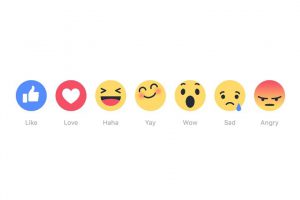Facebook Globally Launches Emoji ‘Reactions’
 Facebook has heard its users’ feedback loud and clear. For years, the networking conglomerate has been receiving requests for a “Dislike” button in addition to the “Like” button (I submitted one of those requests). On February 24, after many months of user testing in a number of countries, Facebook delivered so much more than a “Dislike” button with its extravagant expressions options, “Reactions.”
Facebook has heard its users’ feedback loud and clear. For years, the networking conglomerate has been receiving requests for a “Dislike” button in addition to the “Like” button (I submitted one of those requests). On February 24, after many months of user testing in a number of countries, Facebook delivered so much more than a “Dislike” button with its extravagant expressions options, “Reactions.”
The expressions are more or less an addition to the “Like” button, and people are excited about the upgrade. The “Reactions” allow you to choose from five different animated emojis, each expressing one of the new reactions. Now, when your old college roommate posts a throwback from a night out, you can “like,” “love,” “wow,” “haha,” or be “sad” or “angry” at the memory.
To access these new reactions, simply roll your mouse over the original “Like” button and take your pick. It’s fantastic—Facebook has finally realized not every post is likeable.
It’s a fact that when people speak to us, we derive 70% of their meaning from their body language. Knowing that we can’t see or come in contact with our Facebook “friends” all of the time, Facebook is doing its best to give us another way to express ourselves aside from updating statuses and profile pictures. If you’re angry at that jerk for taking your parking space and making you late for work, you know what? So am I. BOOM—giant red angry face and all of a sudden my “sorry that sucks” comment gets a whole lot livelier.
In all seriousness, Facebook is a strong enterprise that continues to keep up with the times. It isn’t afraid to make changes or challenge people’s familiarity with the site. The popular social media outlet works endlessly to retain its users’ attention, as well as to bring in new users. Kids are starting to join Facebook at younger and younger ages, much of them are drawn in by the variety of games the site offers.
As someone who aspires to work in PR, I’m a fan of social media, but in different ways. Social media is designed for networking, connecting and sharing. These days it’s easy to share too much. Social media should have a primarily positive presence—people want to know the good stuff. You receive what you put out into the world, so you should share only the good, life-changing, need-to-know things. Graduations, weddings, babies, job promotions, moves, road trips, business initiatives, events—I could go on forever about what’s really worth sharing.
Although Facebook hasn’t given us the longed-for “Dislike” button, we can now express our laughter at cat videos and memes with joyful animation instead of using a never-ending stream of “haha.” Thanks, Facebook, for these not-so-subtle, colorful, expressive time-savers.




